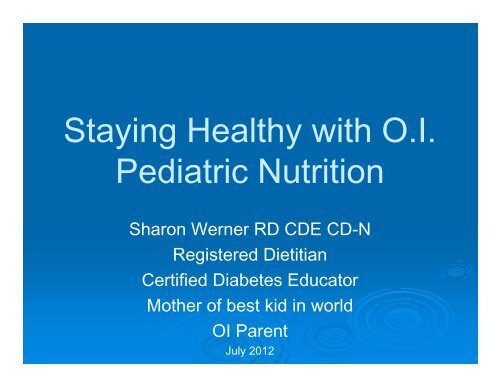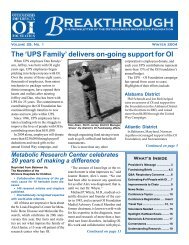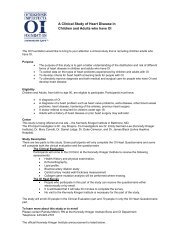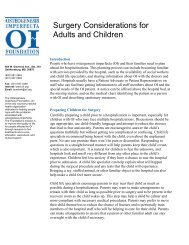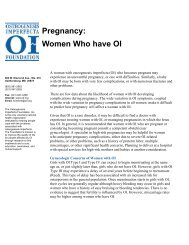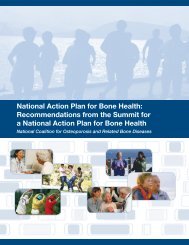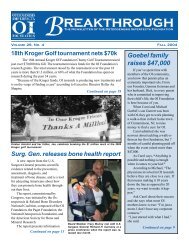Staying Healthy with O.I. Pediatric Nutrition
Staying Healthy with O.I. Pediatric Nutrition
Staying Healthy with O.I. Pediatric Nutrition
Create successful ePaper yourself
Turn your PDF publications into a flip-book with our unique Google optimized e-Paper software.
<strong>Staying</strong> <strong>Healthy</strong> <strong>with</strong> O.I.<br />
<strong>Pediatric</strong> <strong>Nutrition</strong><br />
Sharon Werner RD CDE CD-N<br />
Registered Dietitian<br />
Certified Diabetes Educator<br />
Mother of best kid in world<br />
OI Parent<br />
July 2012
Disclosures<br />
‣ Connecitcut Children’s Medical Center:<br />
Endocrinology<br />
• Dietitian – Diabetes Educator<br />
‣ Animas / LifeScan<br />
• Insulin pump trainer<br />
‣ Medical <strong>Nutrition</strong> Therapy Associates:<br />
• Director<br />
• Private practice nutrition counseling and<br />
weight management: In person and Skype
<strong>Nutrition</strong> Related Health Issues<br />
‣ Constipation<br />
‣ Swollowing difficulties<br />
‣ Failure to Thrive<br />
‣ Small appetites, big energy needs<br />
‣ Weight Management<br />
‣ General good nutrition<br />
‣ Vitamin D and Calcium<br />
‣ Getting Active
Preventing Constipation<br />
‣ An ounce of prevention is better than a pound of cure!<br />
‣ Causes reduced appetite and vomiting<br />
‣ Constipation vs encopresis (incontinence of feces not due to organic<br />
defect or illness)<br />
‣ Causes:<br />
• Medications (anti-seizure, pain meds – especially opiods,<br />
antidepressants, antihistamines)<br />
• Low fiber diet<br />
• Inadequate fluid (not thirsty / avoiding bathroom)<br />
• Nerve damage, pelvic shape, hypotonia, obesity<br />
• Stress, ignoring the urge<br />
• Calcium and iron supplements, diet changes<br />
• Inactivity
How much fiber?<br />
‣ Old Way: Age plus 5g, or 0.5g/Kg per day, or 14g /<br />
1000 calories<br />
‣ Adequate Intake (per NIH)<br />
‣ 0-6 months<br />
None set<br />
‣ 7-12 months None set<br />
‣ 1-3 years<br />
19 g/day<br />
‣ 4-8 years<br />
25 g/day<br />
‣ Boys 9-13 years 31 g/day<br />
‣ Boys 14-18 years 38 g/day<br />
‣ Girls 9-13 years 26 g/day<br />
‣ Girls 14-18 years 26 g/day
How much fluid?<br />
‣ For infants and children:<br />
• 1-10 kg 100-150 mL/kg<br />
• 11-20 kg Add 50 mL/kg over 10 kg<br />
• >21 kg Add 25 mL/kg over 20 kg<br />
‣ Adolescents:<br />
• 40-60 mL/kg
Resolving constipation<br />
‣ Increase fiber, especially soluble fiber<br />
‣ Drink plenty of water to avoid obstructions<br />
‣ Physical activity<br />
‣ Avoid laxatives: they reduce vitamin D<br />
absorption and cause dependence<br />
‣ Love that Miralax (Polyethylene Glycol): start the<br />
same day you start pain meds<br />
‣ Colace (stool softener)<br />
‣ Initiate bowel retraining program
Fiber Sources<br />
‣ Start slooowly (too much = > constipation and <<br />
calories)<br />
‣ Fruits and vegetables = best choices<br />
‣ Beans, peas and lentils<br />
‣ Nuts and Seeds (choking hazard < 3 years /<br />
lying down)<br />
‣ Whole Grains and Oatmeal<br />
‣ Strive for Five (5 g fiber per serving)<br />
‣ Supplements and mineral oil (last resort – can<br />
cause nutrient deficiencies)
Swallowing Difficulties<br />
‣ Aspiration<br />
‣ Gastroesophageal reflux (GER)<br />
‣ Frequent pneumonia may result from<br />
silent aspirations (no cough)<br />
‣ Needs to be assessed by a Speech<br />
Therapist<br />
‣ May need a barium swallow test
Signs of swallowing difficulties<br />
‣ Facial weakness, decreased sensation<br />
‣ Congestion, noisy “wet” sounds<br />
‣ Coughing/choking/gagging before, during<br />
or after a swallow<br />
‣ Food refusal<br />
‣ History of upper respiratory infections<br />
‣ Poor intake<br />
‣ Inefficient and lengthy mealtimes<br />
‣ Inappropriate progression of feeding skills
Modified Consistency Meals<br />
‣ Thickened liquids<br />
• rice cereal or commercial thickeners<br />
‣ Liquid<br />
‣ Blenderized (broken jaw)<br />
‣ Pureed (developmental disorders)<br />
‣ Mechanical soft (dental surgery /<br />
transition)<br />
• Chopped, ground or mashed
Failure to Thrive (FTT)<br />
‣ Growth failure under 3 years old<br />
• Altered infant-caregiver interaction<br />
• Delayed development<br />
• Abnormal behavior<br />
• Oromotor or sensory disorders<br />
• Multifactorial<br />
• Secondary due to chronic disease<br />
• inadequate energy intake, inadequate absorption,<br />
excess metabolic demand, or defective nutrient<br />
utilization
FTT Contributors<br />
‣ Too many simple carbs<br />
‣ Over-restricting fat<br />
‣ Excess fluids<br />
• Limit milk to 24 oz per day for 1 and 5 years to promote<br />
adequate intake of other nutrient-dense foods and to prevent<br />
iron-deficiency anemia<br />
• apple juice may induce fructose and sorbitol malabsorption<br />
‣ Iron deficiency<br />
• suboptimal intake or inadequate nutrient absorption, leads to<br />
poor appetite<br />
‣ Vitamin D deficiency: supplement when breast feeding<br />
‣ Vitamin B12 deficiency: Strict vegetarians and Vegans are at risk<br />
‣ Zinc deficiency<br />
• Growth failure, skin lesions, alopecia, irritability, poor appetite
Small appetite – big energy<br />
needs<br />
‣ Children <strong>with</strong> OI may have a higher<br />
metabolic rate<br />
‣ Scoliosis may reduce stomach volume<br />
‣ Pain reduces appetite<br />
‣ Trauma increases energy needs<br />
‣ Control issues<br />
‣ Bathroom issues
Energy dense foods<br />
‣ Heathly fats<br />
• Olive oil, Canola oil<br />
• Nut butters (over 2 years old)<br />
• Nuts (over 3 years old)<br />
• Avocado<br />
• Wheat germ, ground flax seed meal<br />
‣ Saturated fats<br />
• Butter, cream, cream cheese, cheese<br />
‣ Others<br />
• Dried fruits (great for constipation too)
Weight Management<br />
• Underweight:<br />
• Due to: poor appetite (pain), scoliosis (organ<br />
compression), high metabolic rate<br />
• Problems: reduced immunity, hormonal<br />
imbalance, nutrient deficiency, growth stunting<br />
• Overweight:<br />
• Due to: lack of physical activity, excessive calories,<br />
hormonal imbalance<br />
• Problems: musculoskeletal stress, fractures,<br />
diabetes, heart disease
Ideal Body Weight<br />
‣ BMI: (pounds / (inches * inches) * 703<br />
• E.g. Weight 50 lb. Height 42 inches<br />
• BMI is 19.9<br />
Ideal adult BMI is 19 – 25. 27 or 28 is closer to<br />
the norm for adults <strong>with</strong> OI.<br />
Waist circumference: not a valid measure for<br />
people <strong>with</strong> OI<br />
How do you feel about yourself?
Healthier Food Choices<br />
‣ The basics:<br />
• Eat lots of non-starchy vegetables (1/2 your plate)<br />
• Choose whole grains<br />
• Include dried beans and lentils<br />
• Include fish 2-3 times per week (Omega 3s)<br />
• Choose lean meats<br />
• Non-fat dairy<br />
• Don’t “drink your calories”<br />
• Small quantities of liquid fats<br />
• Watch out for “snack attacks”<br />
• Beware of “portion distortion” - even <strong>with</strong> “health foods”
Wise Choices<br />
‣ Subway vs MacDonalds<br />
‣ Salad Bar vs Pizza<br />
‣ Mustard or hummas vs Mayonaise<br />
‣ Water vs Soda or Juice<br />
‣ Grilled vs fried<br />
‣ Lemon juice + herbs vs butter + salt<br />
‣ Whole wheat vs refined or white<br />
‣ Fish vs Spare Ribs or Rib-Eye<br />
‣ Fruit vs Candy
Look familiar?
General Good <strong>Nutrition</strong><br />
‣ Aim for a healthy weight by choosing sensible portions<br />
and being physically active every day<br />
‣ Eat at least 5 servings of vegetables and fruits every day<br />
‣ Choose a variety of grain foods, especially whole grains<br />
‣ Choose plenty of Calcium rich foods<br />
‣ Limit saturated and trans fat, and cholesterol and<br />
moderate total fat<br />
‣ Limit caloric beverages (including 100% fruit juice,<br />
“punches”, iced teas, Gatorade/vitamin water, soda)<br />
‣ Moderate the use of salt<br />
‣ Avoid alcoholic beverages
Plate Method
Meal Planning<br />
• Plate Method – good starting point for<br />
nutritionally balanced meals<br />
• Counting Carbs – great for weight loss AND<br />
BG control<br />
• Helps minimize junk food<br />
• 1 – 3 yrs 25 to 40g per meal, less than 6g snack<br />
• 4 – 7 yrs 35 to 50g per meal<br />
• 8 - 12 yrs 50 – 65g per meal<br />
• 13 – 18 yrs 65 to 85g per meal
Dairy<br />
‣ High in protein, calcium and vitamin D<br />
‣ Fat free or 1% milk or yogurt<br />
‣ Avoid “fruit on the bottom”<br />
‣ Why go Greek? – Loaded <strong>with</strong> protein<br />
‣ Lactaid or enriched soy<br />
‣ Rice milk = very little protein<br />
‣ Cheese – limit to 1 oz of low fat per day
Fruit<br />
‣ All fruit has carbs<br />
‣ NO fruit juice unless BG is low<br />
‣ Fresh or frozen (no added sugar)<br />
‣ Size counts!<br />
• 1 serving = 1 fist size (big kids get more)<br />
• 1 banana = 2 servings<br />
• 2 to 3 servings per day<br />
‣ Great in salads or as a snack
Low Carb Vegetables<br />
‣ Fresh or frozen (no sauces)<br />
‣ The more the merrier<br />
‣ Dipping raw veggies<br />
• Hummus, salsa, fat free cottage cheese<br />
‣ Let the kids grow them<br />
‣ Sneak them on sandwiches<br />
‣ Try new recipes www.allrecipes.com
Grains / High Carb Veg<br />
‣ Size counts! ½ cup – 1 cup total<br />
‣ Grains:<br />
• Rice, pasta, couscous, barley, quinoa<br />
‣ High Carb Vegetables:<br />
• Potatoes, sweet potatoes, yams, peas, corn,<br />
lima beans, winter squash, plantains
Protein<br />
‣ Keep it Lean!<br />
‣ Eggs, fish, chicken, turkey<br />
‣ Meatless Mondays (great for the budget)<br />
• Beans, lentils, tofu, tempeh<br />
‣ Avoid: sausages, hotdogs, ribs, bacon<br />
‣ Grill or bake – Limit fried food<br />
‣ Avoid the breading
Also important…….<br />
• High fructose corn syrup Fructose and<br />
NAFLD<br />
• Good reason to eliminate juice and soda!<br />
• Check labels for high fructose corn syrup<br />
• Vitamin D: RDA for teens is 600 IU per day<br />
• Probably not enough, especially for obese teens<br />
and teens <strong>with</strong> poor diets<br />
• Up to 80% are deficient / insufficient<br />
• Usually on 1,000 IU daily or Replesta 50,000 IU<br />
weekly for 8 to 12 weeks, then maintenance.
Vitamin D and Calcium<br />
‣ Like PB and J, they go together<br />
‣ Calcium:<br />
• 0-6 months 200 mg/day<br />
• 7-12 months 260 mg/day<br />
• 1-3 yrs 700 mg/day<br />
• 4-8 yrs 1000 mg/day<br />
• 9-18 yrs 1300 mg/day<br />
• > 18 years 1000 mg/day<br />
• Women > 51 1200 mg/day<br />
• Men > 71 1200 mg/day<br />
• No weight related guidelines available
Calcium<br />
• Influenced by:<br />
• Protein, caffeine, soda, fiber, bone turnover (urine<br />
loss), age, obesity, medications, and fat<br />
malabsorption<br />
• Min. 700 mg per day Max 4000 mg (UL)<br />
• Aim for 1000 to 1300 mg, ideally from food<br />
• Supplements: Calcium Citrate or Calcium<br />
Carbonate (<strong>with</strong> food)<br />
• Small doses, twice a day (cut tablet in half)
Calcium Sources (mg)<br />
‣ Fortified oatmeal, 1 packet 350<br />
‣ Cheddar cheese, 1½ oz. shredded 306<br />
‣ Milk, nonfat, 1 cup 302<br />
‣ Yogurt, plain, low-fat, 1 cup 300<br />
‣ Tofu, firm, <strong>with</strong> calcium, ½ cup 204<br />
‣ Orange juice, fortified <strong>with</strong> calcium, 4 oz. 150<br />
‣ Salmon, canned, <strong>with</strong> edible bones, 3 oz. 181<br />
‣ Baked beans, 1 cup 142<br />
‣ Cottage cheese, 1% milk fat, 1 cup 138<br />
‣ Frozen yogurt, vanilla, soft-serve, ½ cup 103<br />
‣ Cheese pizza, 1 slice 100<br />
‣ Turnip greens, boiled, ½ cup 99<br />
‣ Broccoli, raw, 1 cup 90
Vitamin D – A Powerful Hormone<br />
‣ Needed for:<br />
• Calcium absorption<br />
• Calcium / Phosphate balance: N.B. ESRD<br />
• Bone remodeling<br />
• Immune function<br />
• Control of inflammation<br />
• Modulates many genes encoding proteins that<br />
regulate cell proliferation, differentiation, and<br />
apoptosis (cancer promotion or prevention?)<br />
• Pain Management? (Shriner’s research)<br />
• Prevention of DM, HTN, IGT, MS ?
Vitamin D Sources<br />
‣ Produced endogenously (by our bodies)<br />
when ultraviolet rays on the skin trigger<br />
Vitamin D synthesis<br />
‣ Food:<br />
• Egg yolks, nuts, beans, salmon, tuna,<br />
mackerel, poultry, lean meats, fortified foods<br />
‣ Supplements<br />
• D2 (ergocalciferol)<br />
• D3 (cholecalciferol)<br />
• D3 is up to 3 times more effective at raising<br />
serum calcidiol levels (contraversial).
Vit D: Why so many names?<br />
‣ Vitamin D must go through 2 processes to<br />
become active:<br />
• The liver converts vitamin D to calcidiol, or<br />
25 hydroxyvitamin D, written as 25 (OH)D.<br />
This is what the blood tests measure.<br />
• Then the kidney converts calidiol to the active<br />
form: a hormone called calcitriol, or<br />
1,25 – dihydroxyvitamin D,<br />
written as 1,25 (OH) 2 D
Testing Vitamin D levels<br />
‣ Serum concentration of 25(OH)D (calcidiol) is<br />
the best indicator of vitamin D status due to its<br />
long half-life of 15 days<br />
‣ Does not reflect body stores (fat soluble)<br />
‣ The active form, 1,25 (OH) 2 D (calcitriol) is NOT<br />
a good indicator of vitamin D status as it has a<br />
very short half-life of 15 hours, and is closely<br />
regulated by parathyroid hormone, calcium and<br />
phosphate.<br />
‣ Calitriol levels only drop when deficiency is very<br />
severe
Vitamin D<br />
IOM Report 2011<br />
Age Calcium RDA UL Vitamin D RDA UL<br />
mg mg IU<br />
0 to 6 mths 200 1000 400 1000<br />
6 to 12 mths 260 1500 400 1500<br />
1 to 3 years 700 2000 600 2500<br />
4 to 8 years 1000 2500 600 3000<br />
9 to 13 years 1300 3000 600 4000<br />
14 to 18 years 1300 3000 600 4000<br />
19 to 30 years 1000 2500 600 4000<br />
RDA for Calcium: Meets needs of > = 97.5% of population<br />
RDA for vitamin D: supports serum 25OHD level of 20 ng/ml
How much is too much?<br />
‣ UL, per NIH, is 4000 IU: some prescribe more<br />
‣ Intake level at which Vitamin D is toxic is unknown<br />
‣ Sun exposure and food, other than cod liver oil, do not<br />
cause toxicity.<br />
‣ Toxicity more likely from long-term supplements<br />
‣ Large doses for a short period increase stores, not<br />
toxicity. E.g. 50,000 IU /week for 8 weeks<br />
‣ Serum calcidiol:<br />
• < 20 ng/ml = deficient<br />
• 20 – 29 ng/ml = insufficient<br />
• 30 ng/ml or more = adequate<br />
• >200 ng/ml (>500 nmol/L) = potentially toxic
Risks of Overdosing Vit D<br />
• Kidney stones (17 to 20% increase)<br />
• Pancreatic Cancer (Finnish study)<br />
• Birth defects<br />
• Excessive Calcium blood levels, altered<br />
mental status, arythmia<br />
• Delayed sexual maturity<br />
• Side effects: nausea, vomiting, poor appetite,<br />
constipation, weakness, and weight loss.
Getting Active<br />
‣ Benefits of increased physical activity<br />
• Improved functioning of cardiovascular system<br />
• Improved strength and physical work capacity (N.B. lungs)<br />
• Enhanced mobility and balance (less falls - less fractures)<br />
• Decreased risk for coronary artery disease (CAD)<br />
• Lower LDL and triglycerides<br />
• Higher HDL<br />
• Lower blood pressure<br />
• Reduced stress / improved quality of life and self-esteem<br />
• Reduced weight<br />
• Reduced insulin resistance / increased insulin sensitivity<br />
• Reduced hyperinsulinemia (proposed risk factor for<br />
atherosclerosis)<br />
• Enhanced fibrinolysis / less risk of clotting<br />
• Higher lean muscle: body fat ratio (burns more calories at rest)
Getting Active<br />
‣ Medical clearance for physical activity<br />
‣ Customizing an exercise regimen that’s right for you<br />
• Minimize risk of injury<br />
• Avoid boredom: Mix it up<br />
• Make it time effective<br />
‣ Get professional help<br />
• Physical Therapist<br />
• Rehabilitation Specialist<br />
‣ Implementing<br />
• Schedule it!<br />
• Make it a priority<br />
• Buddy up<br />
• Ideas: Wii Fit, swimming, chair exercises, deep breathing
Use your health-care team<br />
‣ Medical <strong>Nutrition</strong> Therapy (MNT) provided<br />
by a Registered Dietitian (R.D.)<br />
• Part of your health-care team<br />
• Diagnose underlying nutrition issues<br />
• Individualize plan for lifestyle changes<br />
• Treat to goals for weight, blood glucose,<br />
cholesterol, blood pressure<br />
• Translate research into useable information<br />
• Improve health and quality of life
Conclusion<br />
‣ Get tested today: Annual physical<br />
‣ Expand your knowledge<br />
‣ Set achievable goals<br />
• Measurable<br />
• Realistic<br />
‣ Modify lifestyle <strong>with</strong><br />
• Healthier food choices<br />
• Daily physical activity<br />
‣ Tap into local resources<br />
You’re not alone<br />
References: http://www.nutritioncaremanual.org/


